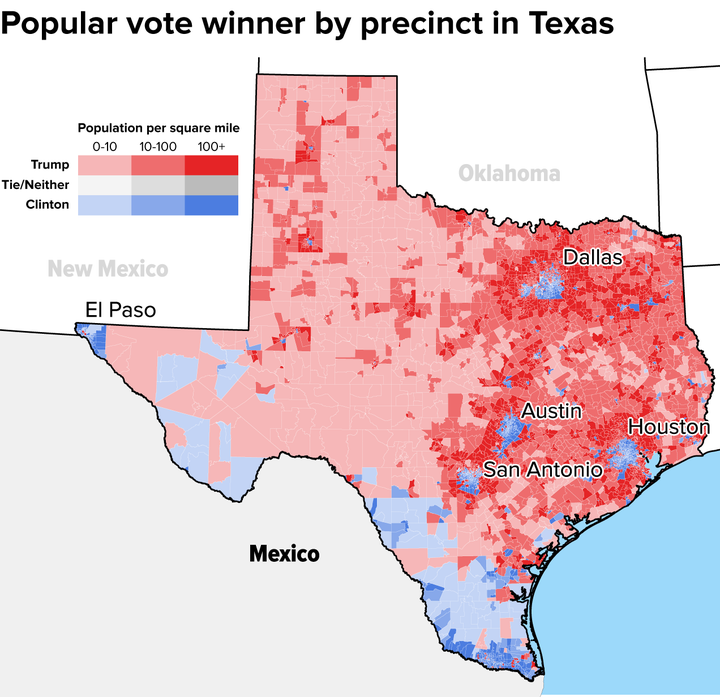AUSTIN, Texas ― One of President Donald Trump’s first actions in office was to order the expansion of the fence on the U.S.-Mexico border, arguing that he was fulfilling a campaign promise.
But many of those who will have to live alongside the wall don’t see a need for it, and a precinct-by-precinct tabulation of voting results from Texas shows they voted overwhelmingly for Clinton.

Source: Texas Legislative Council.
Some 701,000 ballots were cast in Texas precincts within 100 miles of the border. In those precincts, twice as many voters picked Clinton as Trump.
Trump won his election largely by railing against illegal immigration, deriding the North Atlantic Free Trade Agreement as a bad deal and by portraying the U.S.-Mexico border as a lawless area that needs a multibillion-dollar wall to make it more secure.
Those arguments appealed to red state voters and flipped Democratic strongholds in the Midwest, where the manufacturing economy declined in recent decades and wages have stagnated.
But those areas are nowhere near the border itself, where people usually view the situation differently. Not only did Trump lose the Rio Grande Valley, he lost it by whopping margins of more than 50 percentage points in some counties.
The Texas data reveals a more extreme but consistent version of what happened along the rest of the borderlands. While Trump won two out of the four states that touch the U.S.-Mexico border, Clinton won more than 60 percent of the counties that touch the border itself.
That Southern Texas backed Clinton is no surprise. The heavily Hispanic area region has been a Democratic stronghold for years, and Trump largely repelled Hispanic voters, especially in the Southwest. The area is home both to people who can trace their roots back to the era of the Texas Revolution and people who migrated in recent years. Spanish is spoken as commonly as English in many border towns.
While Trump has justified last week’s executive order to expand the barrier as a security measure needed to prevent violence from spilling over, residents often view the wall as unnecessary spending that would be better used for schools, hospitals and roads.
That’s partly because the border region is already heavily policed and has long been one of the safest in the United States. El Paso, in West Texas, has for years boasted some of the lowest crime rates of all mid-sized American cities, even as one of the most brutal episodes of Mexican cartel violence raged just across the border in Ciudad Juárez.
Texas Gov. Greg Abbott (R) signed an $800 million package last year to bolster the federal government’s efforts by sending officers from the state’s Department of Public Safety to help patrol the border.
Gilberto Hinojosa, the state Democratic Party chairman, viewed both the state and federal spending as misguided. He’d rather see the money help the region develop economically or educate Valley students. But, at the very least, he thought it should put to rest the notion that the area is violent.
“Do you know that if I drive from La Jolla, Texas, to Laredo that I run into no less than 15 or 16 Department of Public Safety troopers parked on the side of the road every mile or two?” Hinojosa told HuffPost last week, referring to two South Texas border cities. “It’s absurd. These people do nothing but sit there in their car all day long. This is not an effective use of resources.”
The region’s residents are also less likely to view Mexico with hostile eyes, whether or not they are themselves Hispanic. The Rio Grande, which separate the United States and Mexico in Southern Texas, makes for an odd boundary, since rivers unite people by facilitating transportation. The river slices through town after town that, prior the Mexican American War, were unified settlements without borders or fences.
That geography makes for a business climate in which Texas is perhaps more connected to Mexico economically than any other U.S. state, according to Mark Jones, a political scientist at Rice University. The value of Texan exports alone to Mexico are roughly four times larger than those of China, Mexico’s second-largest trading partner. Trump’s calls to renegotiate NAFTA or slap a 20 percent tax on Mexican imports unnerves people who depend on commerce with Mexico for their livelihood.
“[Valley residents] don’t view a need for a wall, and they’re opposed to anything that creates barriers between them and Mexico,” political scientist Mark Jones told HuffPost. “It creates the impression of the border as an insecure and dangerous place where people won’t want to travel or invest.”